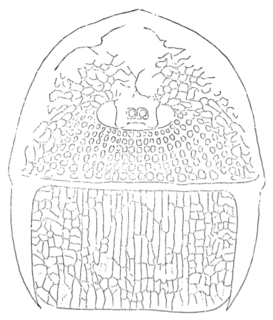
Norman Ira Platnick was an American biological systematist and arachnologist. At the time of his death, he was a Professor Emeritus of the Richard Gilder Graduate School and Peter J. Solomon Family Curator Emeritus of the invertebrate zoology department of the American Museum of Natural History. A 1973 Ph.D. recipient at Harvard University, Platnick described over 1,800 species of spiders from around the world, making him the second most prolific spider taxonomist in history, behind only Eugène Simon. Until 2014 he was also the maintainer of the World Spider Catalog, a website formerly hosted by the AMNH which tracks the arachnology literature, and attempts to maintain a comprehensive list, sorted taxonomically, of every species of spider which has been formally described. In 2007 he received the International Society of Arachnology's Bonnet award, named for Pierre Bonnet, in recognition of his work on the catalog.

Afraflacilla is a genus of the spider family Salticidae. Most species are distributed in Eastern to Northern Africa and Australia, with one species found in Europe. This genus was for a time included in the genus Pseudicius, and the boundaries between both genera are disputed. In 2016 Jerzy Prószyński erected the genus Psenuc for some borderline species. The name Afraflacilla is combined from Africa, where most earlier described species were found, and FlacillaSimon, 1901, an obsolete salticid genus now called FlacillulaStrand, 1932. This genus name is in turn derived from Aelia Flaccilla, wife of Roman Emperor Theodosius I. Afraflacilla, Pseudicius, Festucula and Marchena are close relatives and form a monophyletic group.
The Halidae were a tiny spider family with only three described species in two genera. As of 2006, this family was no longer considered valid; the two genera are instead grouped in the family Pisauridae.

Brachyopterus is a genus of prehistoric eurypterid of the family Rhenopteridae. It is one of the earliest known eurypterids, having been recovered from Middle Ordovician deposits in Montgomeryshire, Wales. Though other species have been assigned to it in the past, Brachyopterus is today recognized as containing one valid species, B. stubblefieldi.
Grossopterus is a genus of prehistoric eurypterid classified as part of the family Waeringopteridae. The genus contains two species, G. inexpectans from Gilboa, United States and G. overathi from Overath, Germany.

Drepanopterus is an extinct genus of eurypterid and the only member of the family Drepanopteridae within the Mycteropoidea superfamily. There are currently three species assigned to the genus. The genus has historically included more species, with nine species associated with the genus Drepanopterus, however five of these have since been proven to be synonyms of pre-existing species, assigned to their own genera, or found to be based on insubstantial fossil data. The holotype of one species proved to be a lithic clast.

Waeringopterus is a genus of prehistoric eurypterids from the Silurian of North America. The genus contains two species, W. apfeli from the Syracuse and Vernon Formations of New York and Ontario and W. cumberlandicus from the Wills Creek Formation, West Virginia. Fossils of the genus also were found in the Indian Point Formation of Quebec.

Kokomopterus is a genus of prehistoric eurypterid. The genus contains a single species, Kokomopterus longicaudatus, known from the Silurian of Kokomo, Indiana.

Erieopterus is a genus of prehistoric eurypterid found in Silurian to Devonian-aged marine strata of Europe and North America. The genus contains eight species from the Silurian to the Devonian, recovered from both North America and Europe.

Parastylonurus is a genus of prehistoric eurypterid. It is classified within the Parastylonuridae family and contains three species, P. hendersoni and P. ornatus from the Silurian of Scotland and P. sigmoidalis from the Silurian of England.

Strobilopterus is a genus of prehistoric eurypterid of the family Strobilopteridae. The genus contains four species, two from the Devonian of Wyoming, United States, one from the Devonian of Ohio, United States and one from the Silurian of Estonia.

Stylonurus is a genus of prehistoric eurypterid of the family Stylonuridae. The genus contains three species: Stylonurus powriensis from the Devonian of Scotland, Stylonurus shaffneri from the Devonian of Pennsylvania and Stylonurus perspicillum from the Devonian of Germany.

Hardieopterus is a genus of prehistoric eurypterid classified within the family Hardieopteridae. The genus contains four species, all Silurian in age; H. lanarkensis and H. macrophthalmus from Scotland, H. megalops from England and H. myops from the United States.

Mycterops is a genus of prehistoric eurypterid of the family Mycteroptidae. Mycterops lived during the Carboniferous period in Europe and North America.
Speleoticus is a spider genus in the family Nesticidae. Its species are found in Japan and China.
Aituaria pontica is an araneomorph spider of the family Nesticidae. It occurs in the Krasnodar region of Russia and in Georgia.
Saphrys tehuelche is a species of jumping spider. The species was classified in the genus Euophrys from 1968, when it was first described by María Elena Galiano, until 2015. It can be found in Chile.

Hyllus giganteus, commonly referred to as the giant jumping spider, is a jumping spider native from Sumatra to Australia. It is best known for being the largest jumping spider species known to science, ranging from 1.8–2.5 centimetres (0.71–0.98 in) in length. It is popular among spider hobbyists and breeders as the largest known jumping spider.
Carniella weyersi is a species of comb-footed spider in the family Theridiidae. It is found in China and Sumatra.

Cosmophasis gemmans is a species of jumping spider in the family Salticidae. Only the male has been described. The type specimen is deposited at the Museo Civico di Storia Naturale di Genova.













